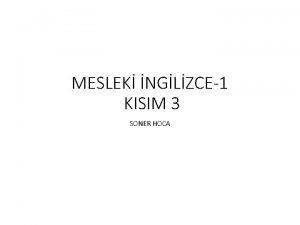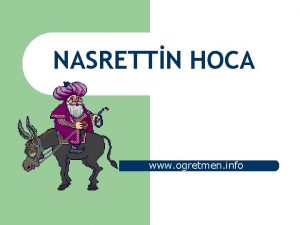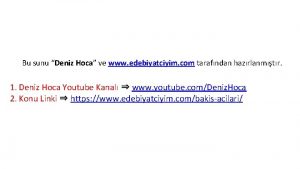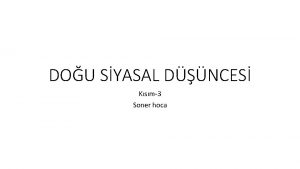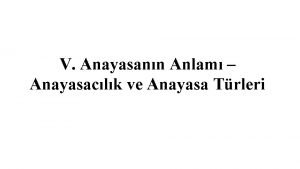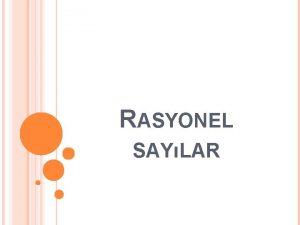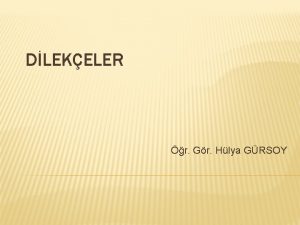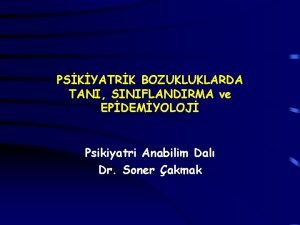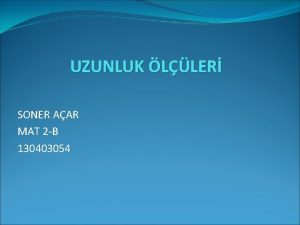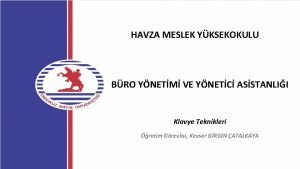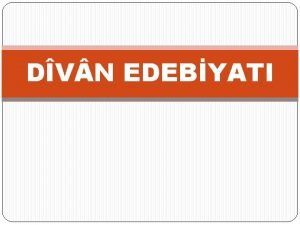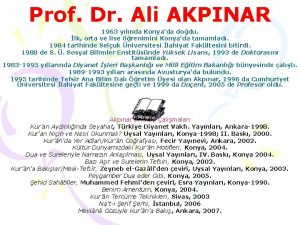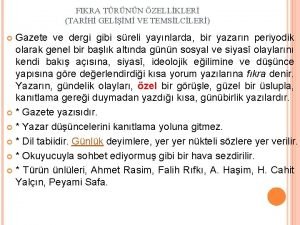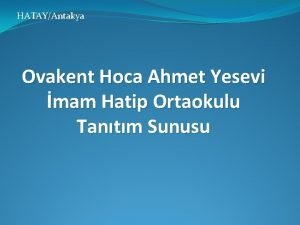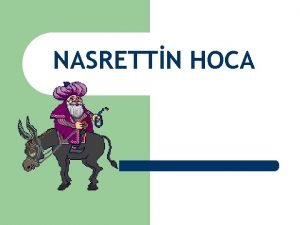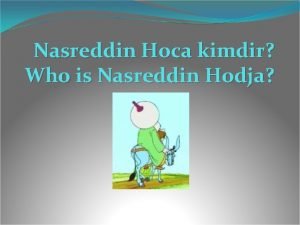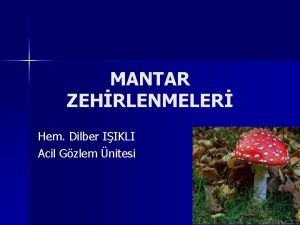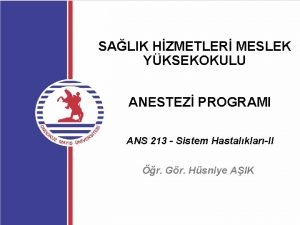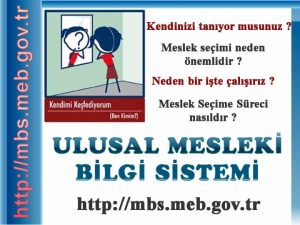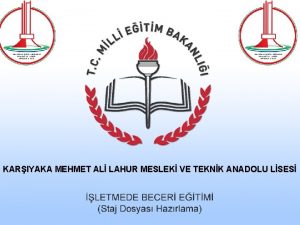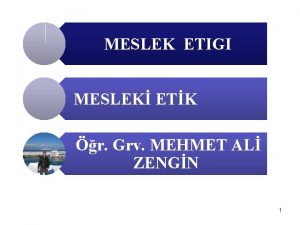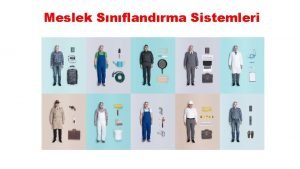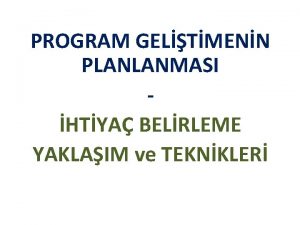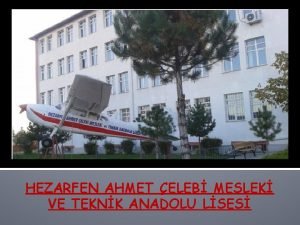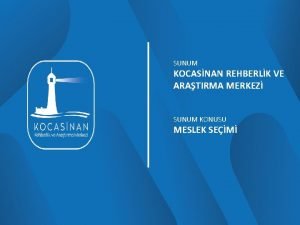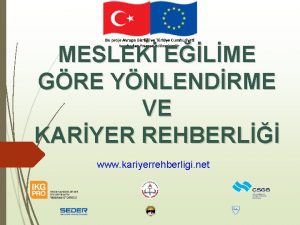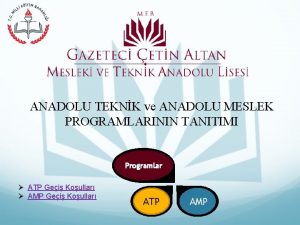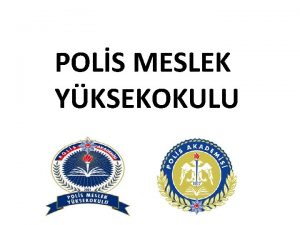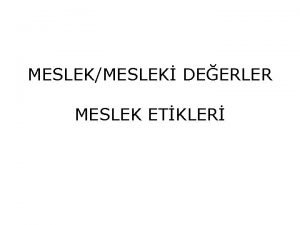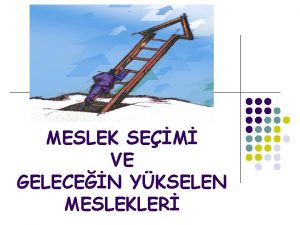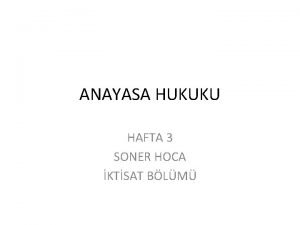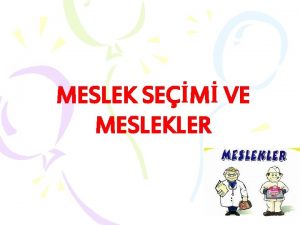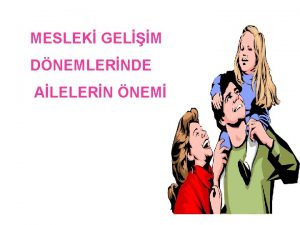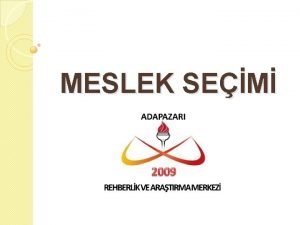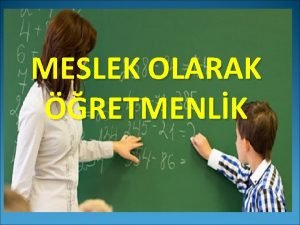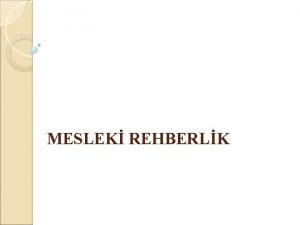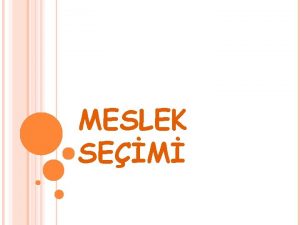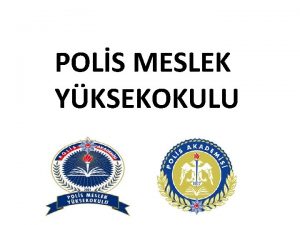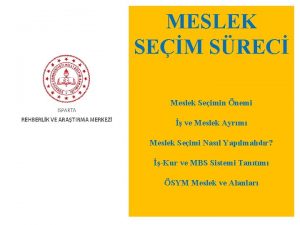MESLEK NGLZCE1 KISIM 3 SONER HOCA Administration TERMINILOGY






































- Slides: 38

MESLEKİ İNGİLİZCE-1 KISIM 3 SONER HOCA

Administration TERMINILOGY

Objectives from the specification • understand that administration involves the storing, processing, retrieving and disseminating of information to support the business functions (i. e. human resources, finance, operations, marketing and sales, customer service and research and development) • be aware of the importance of administration in ensuring the efficient running of a business, enabling it to respond to actual and potential competition • be aware of the range of job roles (ie managers, supervisors and operatives) and be able to identify appropriate titles and responsibilities within different management structures (e. g. flat or hierarchical) • understand the difference between routine tasks (such as filing, inputting data) and non-routine tasks (such as dealing with new product development) • understand the difference between routine and non-routine decisionmaking and identify the appropriate decision-makers • understand the importance of planning, e. g. for a meeting, and the consequences of poor planning for a business • understand the processes involved in planning and prioritising

Name 5 of the main departments in a business • Human resources • Finance • Sales • Marketing • Customer Services • Production • Research and Development

Explain what each of the functional areas is responsible for • Human resources • management of people • Finance • Accurate records of cash flow; predicting profit and loss • Sales • Selling products or services • Marketing • Advertising products/services; knowing what the customer wants • Customer Services • Keeping the customer happy • Production • (if the company makes a product) Making the company’s product(s) • Research and Development • Researching and developing new products

What is administration? • Administration is essential for the smooth running of a business to ensure that they can compete with others in the same field • Administration involves the storing, processing, retrieving and disseminating (passing on) of information that supports the business functions • Administrators perform this function so that managers do not have to and can concentrate on decision making • Typical tasks include preparing sales figures, filing documents, updating databases, sending out mail shots, setting up meetings

Job roles • Within a large organisation there a number of job roles, such as directors, managers, supervisors and operatives (workers) Directors Managers Supervisors Operatives (workers)

What do each of those roles do? • Directors • Responsible for the business’s strategy • Managers • responsible for carrying out the director’s strategy and making day to day decisions • Supervisors • Responsible for carrying out the manager’s instructions and usually look after specific projects or small teams • Operatives • Are not responsible for other staff and are often given specific tasks to perform by managers or supervisors

Routine v’s non-routine tasks • A routine task is one that is performed regularly in the same way. Each area of a business will have its own routine tasks and those will vary depending on the type of the business. • Examples include filing a tax return every year; ordering stock every week; filing documents every day; entering details of invoices into a spreadsheet every day; re-stocking shelves every day • Routine tasks are often carried out by operatives.

Routine v’s non-routine tasks • Non-routine tasks are unpredictable and usually “one off” tasks, such as re-fitting a shop; responding to a customer complaint; developing a new product; upgrading equipment • Non-routine tasks often involve high level decisions and so involve managers

Decisions • Businesses are structured to enable decisions to be made easily. There are far fewer people at the top of the management structure than at the bottom. Decisions are usually made by people at the top of the hierarchy, but decision making powers can be delegated to people lower down in the organisation

Routine v’s non-routine decisions • In the same way as there are routine and non-routine tasks there are routine and non-routine decisions. • Routine decisions involve day to day judgements about the day to day running of the business. For example, a monthly decision about what stationary to order. • A non-routine decision is a more important decision that may have a major effect on the business, for example the decision to open a new shop.

Delegation • Delegation of decision making authority can help to motivate staff and make them feel valued. • Disadvantages are that staff may not know who to go to for a particular decision and if the wrong decision is made and reversed by a manager then the member of staff making the decision will feel bad. • If decisions are frequently delegated then the business is said to have a decentralised structure.

Planning • Poor planning and poor decision making can lead to loss of time and resources and ultimately to business failure. • Planning needs to take place regarding all areas of the business so that it can function. • Planning needs to take place regarding resources so that there are no shortages and regarding staff so that there are enough.

The planning process 1. 2. 3. 4. 5. Identify your objectives Break the project into separate tasks Estimate the time needed for each task and whether they have to done after the other or can be done simultaneously. Set milestones for each task (i. e. dates when they have to be completed) Identify the resources needed (e. g. staff, equipment, materials, money) Think about how outside influences will affect the plan (e. g. suppliers)

Functional Areas of Business • R&D • Marketing • Finance • Production • HR

Functional Area of Business • R&D = Research & Development • New product design and development

Functional Area of Business • Marketing • Planning and executing the conception, pricing, promotion, and distribution of ideas, goods, and services to create exchanges that satisfy individual and organizational objectives

Functional Area of Business • Finance • Revenue, expenses, budget, financial records and financial statements

Functional Area of Business • Production • Extraction and cultivation (products are obtained from nature or grown using natural resources) • Processing (changing and improving the form of another product) • Manufacturing (combines raw materials and processes goods into finished products)

Functional Area of Business • HR = Human Resources • People who work for a business/organization • Involves in planning & staffing, performance management, compensation & benefits, and employee relations

Manager = ?

Who managers are? • Someone who coordinates and oversees the work of other people in order to accomplish organizational goals.

How many level of managers can we classify?

How to classify managers in organizations? Traditional Pyramid Form of Management Level Top Managers Middle Managers First-Line Managers Non-Managerial Employees Functional Areas R&D Marketing Finance Production HR

I. Lowest Level of Management • First-line managers: manage the work of nonmanagerial employees who typically are involve with producing the organization’s products or servicing the organization’s customer • They are often called: supervisor, shift manager, district manager, department manager, office manager

II. Middle Level of Management • Middle managers: manage work of first-line managers • They are often called: regional manager, project leader, store manager, division manager

III. Upper Level of Management • Top managers: are responsible for making organizationwide decisions and establishing the plans and goals that affect the entire organization. • They are often called: executive vice president, managing director, chief operating officer, chief executive officer

What is Management? • Management involves coordinating and overseeing the work activities of others so that their activities are completed efficiently and effectively. • Or Management is the art of getting work done through others

2 Important Words for Management: Efficiency and Effectiveness

Efficiency and Effectiveness Efficiency Effectiveness • Efficiency = getting the most output from the least amount of inputs • “doing things right” • concern with means(ways) of getting things done • Effectiveness = do those work activities that will help the organization reach its goals • “doing the right things” • concern with ends(result) of organizational goal achievement

Efficiency and Effectiveness Efficiency Effectiveness • Efficiency = getting work done with a minimum effort, expense, or waste • (use resources – people, money, raw materials– wisely and costeffectively) • Effectiveness = accomplish tasks that help fulfill organizational objectives • (make the right decisions and successfully carry them out to accomplish the org. goal)

Efficiency and Effectiveness in Management Efficiency (Means) Effectiveness (Ends) Resource Usage Goal Attainment Low Waste High Attainment Management Strives for: Low Resource Waste (high efficiency) High Goal Attainment (high effectiveness)

Management Functions ORGANIZING PLANNING MANAGER LEADING CONTROLLING

1. PLANNING • Define goals • Establish strategies for achieving those goals • Develop plans to integrate and coordinate activities Setting goals and plans (how to achieve them)

2. ORGANIZING • Determine • • • What tasks are to be done ? Who is to do them ? How tasks are to be grouped ? Who reports to whom ? Where decisions are to be made ? Arrange tasks and other resources to accomplish organization’s goals

3. LEADING • Motivate subordinates(lower positions) • Help resolve group conflicts • Influence individuals or teams as they work • Select the most effective communication channel • Deal with employee behavior issues Hire, train, motivate(lead) people

4. CONTROLLING • Monitor activities’ performance • Compare actual performance with the set goals • Evaluate activities’ performance whether things are going as planed • Correct any disturbance to get work back on track and achieve the set goals Ensure all activities are accomplished as planned
 Teamüli anayasa nedir
Teamüli anayasa nedir Functional areas of business
Functional areas of business Nasrettin hoca ramazan fıkrası
Nasrettin hoca ramazan fıkrası Soner hoca
Soner hoca Soner hoca
Soner hoca Soner hoca
Soner hoca Soner hoca
Soner hoca Fenokulu net
Fenokulu net Ondalik sayilari rasyonel sayiya dönüştürme
Ondalik sayilari rasyonel sayiya dönüştürme Dilekçe sahibini dilekçe yazmaya yönelten kısım
Dilekçe sahibini dilekçe yazmaya yönelten kısım Kisim agh
Kisim agh Dsm 5 sınıflandırması
Dsm 5 sınıflandırması M dm cm
M dm cm Kevser emlak havza
Kevser emlak havza Tuhfetü'l harameyn kimin eseri
Tuhfetü'l harameyn kimin eseri Nasreddin durr-u melek
Nasreddin durr-u melek Hoca ahmet yesevi sözleri
Hoca ahmet yesevi sözleri çimlere basma hoca
çimlere basma hoca Saygın hoca çalışma taktiği
Saygın hoca çalışma taktiği Ali akpınar hoca
Ali akpınar hoca Nasrettin hoca fıkraları
Nasrettin hoca fıkraları Ovakent hoca ahmet yesevi imam hatip ortaokulu
Ovakent hoca ahmet yesevi imam hatip ortaokulu Nasrettin hoca akşam üzeri evine doğru
Nasrettin hoca akşam üzeri evine doğru Nasrettin hoca hamam bahşişi
Nasrettin hoca hamam bahşişi Nasreddin durr-u melek
Nasreddin durr-u melek Dilber hoca mantar
Dilber hoca mantar Konduit meslek
Konduit meslek Mesleki bilgi sistemi
Mesleki bilgi sistemi Mehmet ali lahur ticaret meslek lisesi
Mehmet ali lahur ticaret meslek lisesi Iş hayatındaki etik davranışların olumlu sonuçları
Iş hayatındaki etik davranışların olumlu sonuçları Mesleklerin sınıflandırılması
Mesleklerin sınıflandırılması Progel dacum delphi farkı kpss
Progel dacum delphi farkı kpss Hezarfen ahmet çelebi lisesi
Hezarfen ahmet çelebi lisesi Meslek seçimi sunum ortaokul
Meslek seçimi sunum ortaokul Kariyerrehberligi.net
Kariyerrehberligi.net Anadolu meslek programı
Anadolu meslek programı şükrü balcı polis meslek yüksek okulu taban puanı
şükrü balcı polis meslek yüksek okulu taban puanı Meslek kavramı
Meslek kavramı Ykselen
Ykselen

